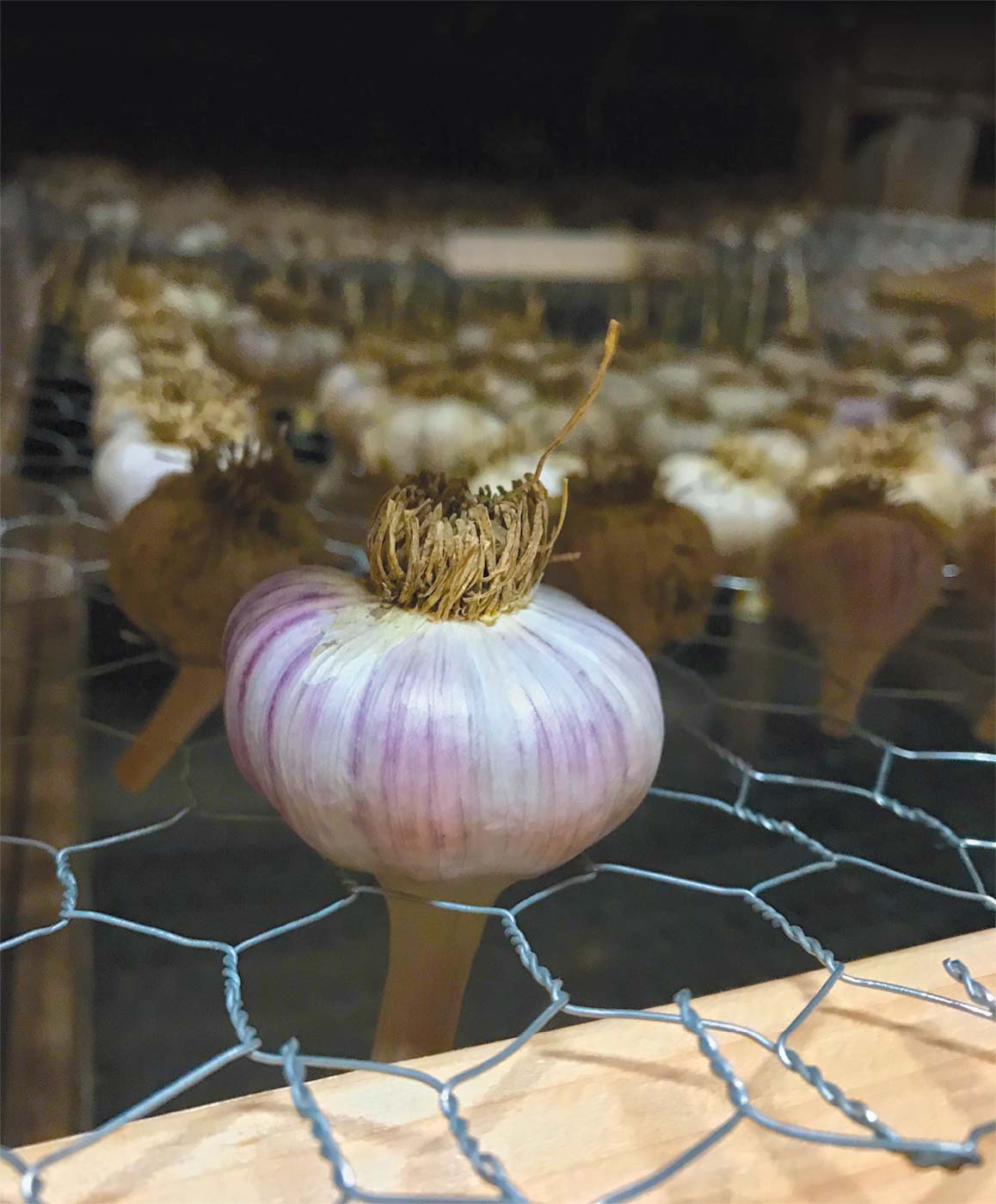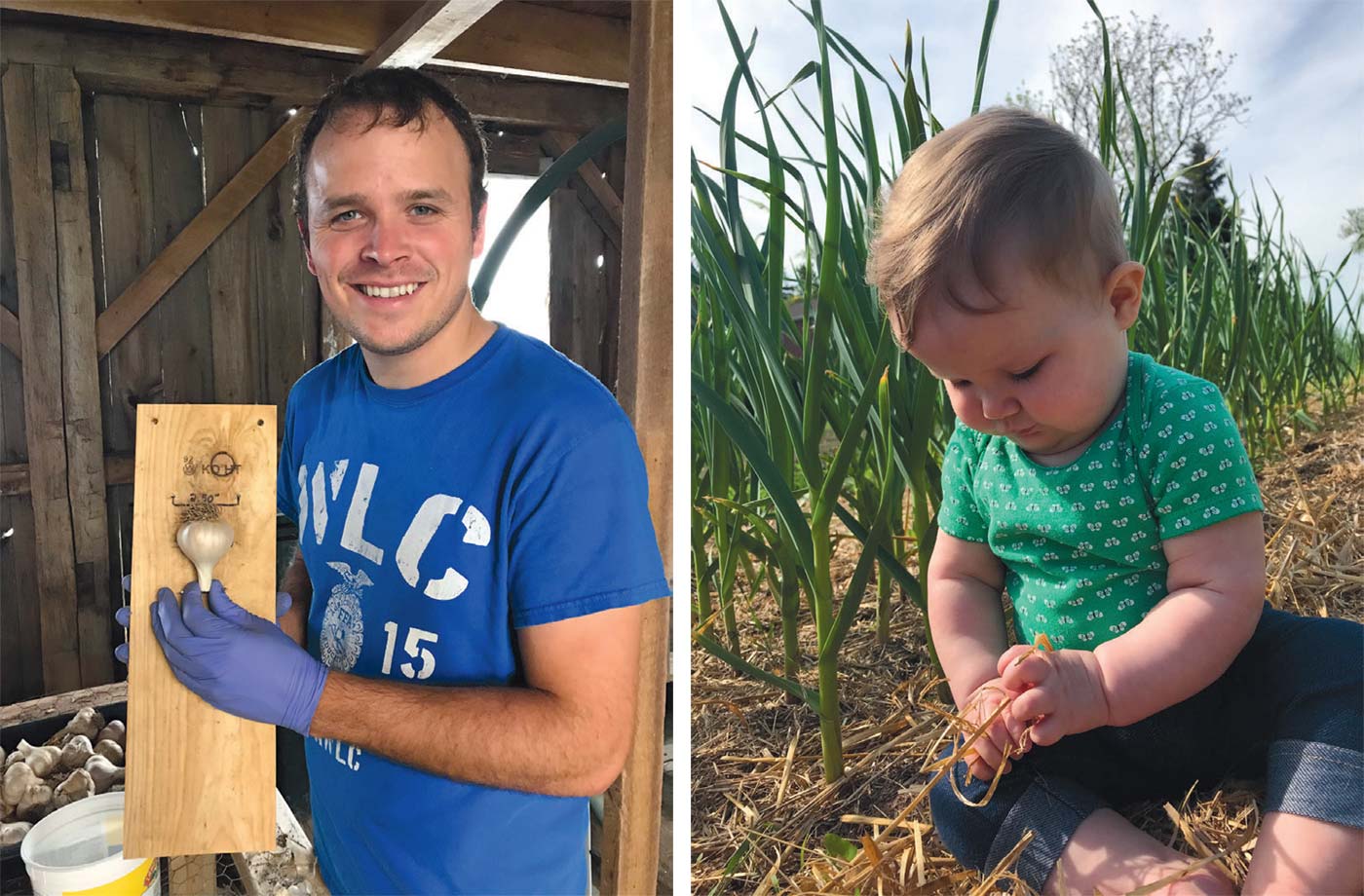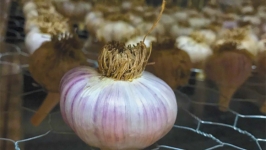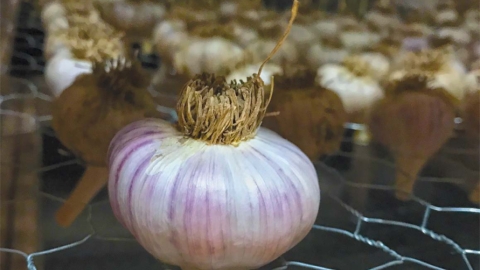An Obsession leads to Guza Garlic
The circle of life has blessed the Guza Garlic farm with a bountiful crop and a new generation of garlic growers.
“I delivered our daughter Mary the day after we planted our second season of garlic,” in October 2019, said Joanna Guza of her fi rst child. “I was definitely in labor while we were planting! I was having cramps here and there, but didn’t think anything of it; we had to get the garlic in. So the garlic was extra special this year, because of her.”
The Guza Garlic hobby farm in Denmark sits on 2.25 acres. When Joanna and Brian Guza bought the property, they put their heads together to figure out what they could grow a lot of on their small acreage. They settled on garlic, mainly due to Joanna’s obsession with the vegetable, which she cooks with as much as possible.
“Garlic is not hard to grow,” she says, “but a lot of people don’t do it, because it’s a lot of labor. There aren’t mechanical tools to plant it with on our small scale. Everything we have here, Brian has built.”
A side gig in garlic was not the couple’s initial dream. They started by planting fi ve pounds of seed garlic in October 2018 to see if they were “good at it.”
“When we were giving (garlic bulbs) away to friends and family, we would joke with people, ‘Try the Guza Garlic’, and here we are,” laughed Joanna. “We’re not going to get rich. But we’re hoping our kids will be involved someday; maybe garlic will be Mary’s future FFA project.”
Joanna, 27, was raised on a dairy farm in Denmark, about a five-minute drive from the couple’s home. Brian, 28, grew up on a beef and dairy farm across the state in Taylor. They met through Future Farmers of America (FFA) – both were student members of the organization and then worked as state FFA officers.
After college, Brian got a job at the Point Beach Nuclear Plant and continues to work there, now as a systems engineer. Joanna works for the Wisconsin Dairy Business Association doing the organization’s marketing and digital communications. “Brian and I are the perfect combo for having the small garlic business: I do the weeding, plant care, social media and website marketing, while Brian does the engineering and construction around the farm. We complement each other well.”
In our northeast Wisconsin climate, hardneck garlic is the type that grows best, Brian said, and there are a multitude of varieties that grow successfully here. Hardneck garlic is identifi able by the hard stem through the middle of the bulb. The Guzas say hardneck garlic has about 10 times as much flavor as the garlic bulbs found in grocery stores, known as softneck garlic, which struggles to grow in Wisconsin because it requires a longer period of warmer temperatures.
The number of cloves each hardneck bulb produces depends on the variety. For example, varietal Siberian has three to four cloves per bulb, while German Red produces eight to 15 cloves. The Guzas planted seven varieties of garlic via 30 pounds of seed cloves in 2020: German Red, Russian Red, Siberian, Spanish Roja, Georgian Fire, Music and Persian Star.
“Each has a different flavor,” Joanna said. “Some are more hot and spicy, others have a deep garlic flavor. If you’re going to eat these raw, it’s going to be spicy! If you’re making salsa, you might not want to add jalapeno, because the garlic will add enough spice. Cooking the garlic will mellow out the flavor.
“I made refrigerator pickles (uncooked) with our garlic. And when the pickles were gone and just the garlic was left in the brine, I ate some. It was so spicy I had to spit it out. Joanna gently warns: “The longer this garlic sits in the fridge, the spicier it gets.”
‘Brian and I are the perfect combo for having the small garlic business: I do the weeding, plant care, social media and website marketing, while Brian does the engineering and construction around the farm. We complement each other well.’ – Joanna Guza

Garlic on the drying racks. Contributed photo.
PREPARING FOR GROWTH
“For our first growing year, we ripped up a small patch next to our existing vegetable garden and planted fi ve pounds of seed garlic,” Brian said. “This last year we borrowed a tiller, tilled up an area 20 feet x 100 feet, mixed in dairy manure from Joanna’s parents’ farm to add nutrients, and planted. That fi rst year, converting our grass yard to a garlic plot, the ground was clumpy and wet.
“So this spring (2020), when we ripped up more soil, we planted crimson clover to help break up the soil and get green manure in there.”
Garlic can be fussy with weeds, if you let the weeds grow. To help minimize weed growth and the amount of weeding labor Joanna does, they top dress with a heavy layer of straw over the planted cloves to protect them for the winter. In the spring, after danger of heavy frost has passed, the Guzas remove some straw, but keep cover on to suppress weed growth.
The Guzas gave their cloves some extra TLC before planting them in 2019 and 2020, which help the cloves survive the winter and sets them up for a successful growing season and harvest the next summer.
To plant the cloves, they separate each clove from the bulb. Then the cloves are soaked for three to four hours in a diluted fish emulsion solution. The cloves are then dunked in a quick vodka bath (about 20 minutes) to ensure there’s no residual bacteria lingering on the bulbs that could cause rot or misshapen growth of the future bulbs.
Noting they’re not making martinis, bottom-shelf vodka works just fine, Brian said.
“Joanna bought the Kirkland brand the first time we did this,” Brian said. “Then we decided we didn’t need to be that fancy.”
Long about mid-July, the garlic is ready to harvest in northeast Wisconsin. The Guzas dig up the bulbs, trim roots and greens off and allow the garlic to “cure” (dry) for three weeks. When cured and stored properly in a cool, dry location, hardneck garlic can last into December. Joanna has also learned that sprouted garlic can be planted in fl ower pots and is a great critter repellent. Joanna recommends storing garlic in a cool, dark, dry area, the same place you keep onions or potatoes. Garlic will eventually sprout.
For their 2021 crop, the Guzas plan to plant 35 pounds of seed garlic. While the exact amount of garlic bulbs and seed that will yield remains to be seen, Brian said he’s hoping to harvest about 100 pounds of garlic.
“We’ll learn what yields are over time,” Brian says. “The weight is so dependent on the number of cloves and size. I like varieties with larger cloves, but they are the least profitable because you get fewer bulbs.”
The number of varieties the Guzas plant will likely be reduced in the future, dependent on yield. Based on Joanna’s excitement about the success of their farming foray, the acreage the couple plant will likely continue to expand.
“We couldn’t believe how many people were interested in our 2020 garlic,” Joanna said. “Family, social media inquiries, people in the Denmark community ... I came home one day, and Brian said, ‘Stop telling people about us, or you’re not going have any left (for personal use)’.
“We’re first generation, rookie garlic farmers who’ve definitely learned a lot in a short period of time,” said Joanna.
Guza garlic scapes (flower stems) will be available for sale in spring/early summer 2021. Joanna makes a pesto sauce with them, and pickles the scapes.
- To inquire about purchasing Guza garlic bulbs in 2021, visit www.guzagarlic.com; or find them on facebook or Instagram: GuzaGarlic.







